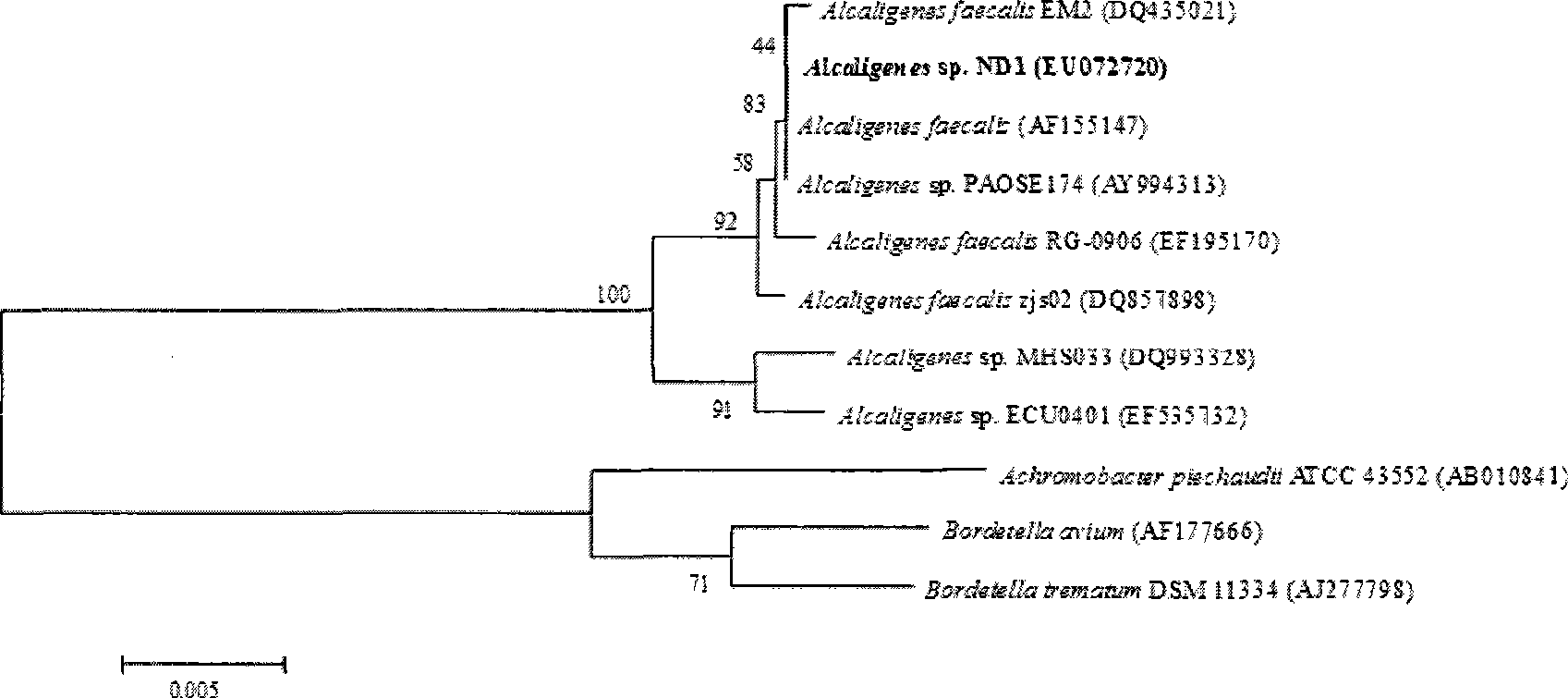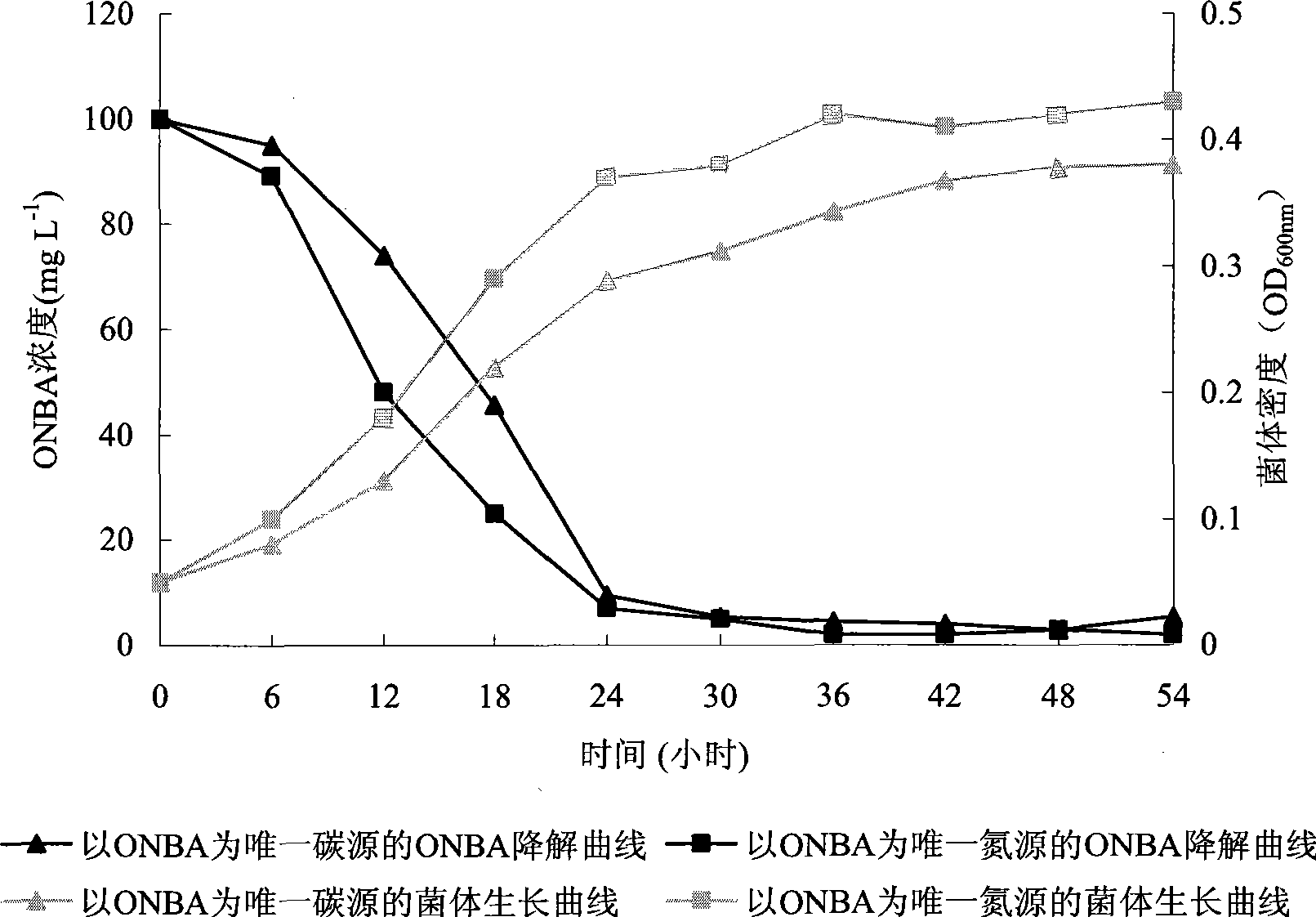O-nitrobenzaldehyde degrading bacteria and use thereof
A technology of o-nitrobenzaldehyde and degrading bacteria, applied in the field of biological treatment of environmental pollutants, can solve the problems of limited application, narrow degradation spectrum, limited number and types of degrading bacteria, etc., and achieve the effect of wide application and broad degradation spectrum
- Summary
- Abstract
- Description
- Claims
- Application Information
AI Technical Summary
Problems solved by technology
Method used
Image
Examples
Embodiment 1
[0026] Embodiment 1: The performance of separation and degradation o-nitrobenzaldehyde of Alcaligenes sp.ND1
[0027] After collecting the activated sludge in the sludge thickening tank of Hangzhou Municipal Sewage Treatment Plant on site, it was packed in a 150mL triangular flask and quickly brought back to the laboratory.
[0028] The retrieved sludge samples were placed in ONBA selective basal inorganic salt liquid medium for acclimation culture. The medium composition is (g / L): Glucose 1.0, NaCl 1.0, K 2 HPO 4 1.5, KH 2 PO 4 0.5, (NH 4 ) 2 SO 4 1. MgSO 4 ·7H 2 O0.2, ONBA 0.1g, add deionized water to make up to 1,000mL, sterilize with moist heat at 115℃ for 30 minutes and set aside. The culture conditions are: 28°C, 150r / min shaking culture, and the liquid volume in the container is 1 / 3 of the container volume. After culturing for 3-5 days, the shake flask was left still for a while, the supernatant was discarded, and then an equal amount of freshly configured sel...
Embodiment 2
[0031] Embodiment 2: Degradation substrate experiment of Alcaligenes sp.ND1
[0032] Inoculate Alcaligenes sp.ND1 to o-nitrobenzaldehyde, naphthalene, p-nitrophenol, o-nitrophenol, o-aminophenol, toluene, p-dimethyl Aminobenzaldehyde, 2,4-dinitrophenol, p-hydroxybenzoic acid, diphenylamine, benzoic acid and dimethylbenzene in the basic inorganic salt culture medium, set up substrate blank control simultaneously (only add substrate and do not add bacteria), After 2 days of shake culture at 150r / min and 30°C in a shaker in the dark, the biomass was measured and the degradation of the substrate was detected. The growth of the strain is shown in Table 2. The results show that the strain ND1 can use a certain concentration of the tested substrate for growth and reproduction, and the tolerance concentration to different substrates is different. The tolerated concentration of the test substrate should be at least 100 mg / L. After cultivating for 2 days, it was observed that the subs...
Embodiment 3
[0040] Example 3: Antibiotic susceptibility experiment of Alcaligenes sp.ND1
[0041] The antibiotic susceptibility test adopts the filter paper method, and five commonly used antibiotics such as ampicillin, tetracycline, chloramphenicol, kanamycin and streptomycin are selected, and the diameter of the inhibition zone of each antibiotic filter paper on the ND1 plate for cultivating degrading bacteria , as a criterion for judging sensitivity or resistance. The test results given in Table 3 showed that the strain ND1 was sensitive to the above five antibiotics.
[0042] Table 3. Results of resistance test of Alcaligenes sp.ND1
[0043]
[0044]
[0045] Note: The diameter of the inhibition zone is greater than the upper limit of the moderately sensitive range as sensitive, less than the lower limit as resistant, and within the range as moderately sensitive.
[0046] This example shows that when the bacteria are released into the natural environment, they will not spread ...
PUM
 Login to View More
Login to View More Abstract
Description
Claims
Application Information
 Login to View More
Login to View More - R&D
- Intellectual Property
- Life Sciences
- Materials
- Tech Scout
- Unparalleled Data Quality
- Higher Quality Content
- 60% Fewer Hallucinations
Browse by: Latest US Patents, China's latest patents, Technical Efficacy Thesaurus, Application Domain, Technology Topic, Popular Technical Reports.
© 2025 PatSnap. All rights reserved.Legal|Privacy policy|Modern Slavery Act Transparency Statement|Sitemap|About US| Contact US: help@patsnap.com



